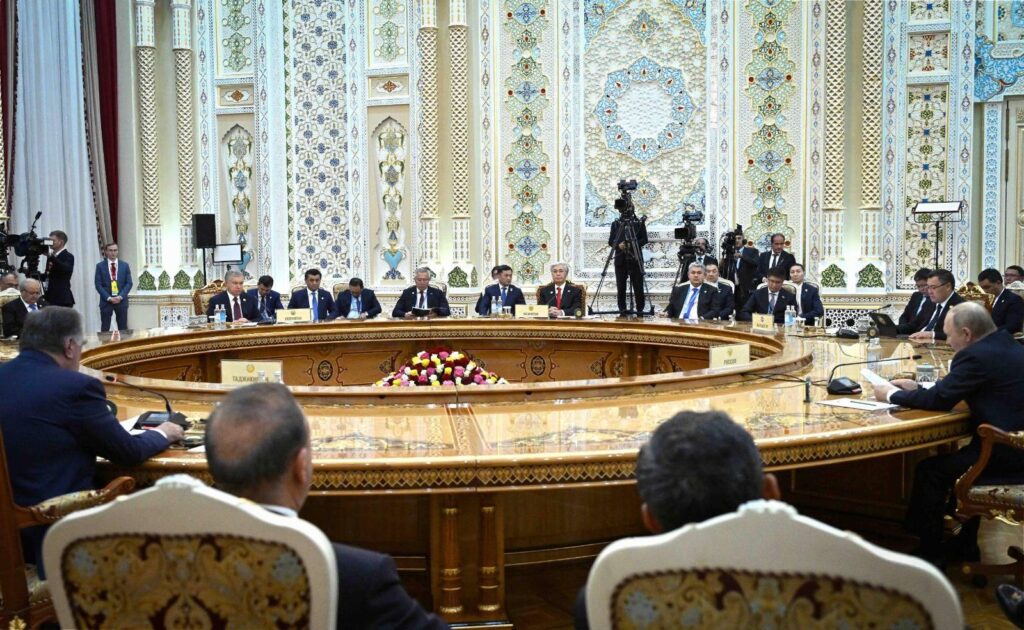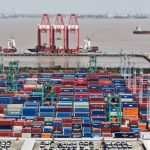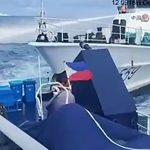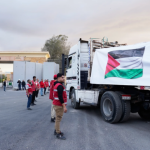
Russia Seeks to Reassert Role at Central Asia Summit, but Kazakhstan and Uzbekistan Push Their Own Agendas
By Andrei Matveev
The second Central Asia-Russia summit, held ahead of the Commonwealth of Independent States (CIS) leaders’ meeting, reaffirmed the Kremlin’s continued intent to assert influence over the region. Russian President Vladimir Putin used the platform not only to signal discontent with the pace of economic integration but also to critique the Central Asian republics for what he portrayed as insufficient engagement in bilateral trade.
Despite growing ties between Central Asian states and external partners, exemplified by the “C5+1” dialogue format that includes major powers such as the U.S. and China, Putin made clear that Russia does not view its influence in the region as diminished.
Opening the summit, Putin took a veiled swipe at the “C5+1” initiative, which has gained traction in recent years. “I am in constant contact with each of the Central Asian presidents,” he said, before adding, “But I am sure that this multilateral format of communication is also very useful and has its obvious ‘added value’, so to speak.”
By “added value,” the Russian leader appeared to suggest that multilateral engagement enables Central Asian states to present a more unified front in foreign negotiations, an approach that complicates Moscow’s ability to exert influence through bilateral channels.
Putin also expressed dissatisfaction with the current levels of mutual trade and Russian investment in the region. While acknowledging that trade between Russia and Central Asia had surpassed $45 billion, he pointedly compared this figure to trade with Belarus, which exceeds $50 billion despite its far smaller population.
“Our trade turnover with Belarus exceeds $50 billion. Let me remind you that Belarus has a population of 10 million. Uzbekistan already has nearly 40 million, Tajikistan over 10 million, and Kazakhstan more than 20 million. Can you imagine what a colossal resource this is?” Putin said. “This means there are strong prospects for expanding our economic relations.”
Putin described Russia’s current $20 billion in regional investments as inadequate and called for increased engagement, but also tempered expectations surrounding major infrastructure and logistics projects championed by Astana and Tashkent, while positioning Russia as a central player in their development. He proposed integrating existing North-South and East-West corridors into a unified Eurasian logistics network supported by digital and transport services.
“This will allow us to significantly increase international transport volumes through our common region,” Putin said.
Kazakh President Kassym-Jomart Tokayev responded directly, updating figures presented by Putin and reaffirming Kazakhstan’s commitment to regional integration. He noted that Russia’s total trade with Central Asia exceeded $50 billion in 2024, with $28 billion in trade between Russia and Kazakhstan alone.
Tokayev emphasized the strategic importance of transport cooperation with Russia, stating that “Russia is a key gateway for the region’s countries to global markets. Therefore, cooperation in the transport and logistics sector is a matter of heightened strategic importance.”
Tokayev outlined Kazakhstan’s existing transport infrastructure, eleven international corridors, including five rail and six road routes, that carry about 85% of land freight between Asia and Europe. Over 15 years, Kazakhstan has invested more than $35 billion in the sector. As a result, rail transit from Russia to Central Asia via Kazakhstan has risen 26% over three years, with traffic in the opposite direction growing by nearly 50%. Deliveries from Russia to China via Kazakhstan have tripled, exceeding five million tons.
He proposed launching a joint Kazakh-Russian investment and infrastructure program for the eastern segment of the North-South corridor, with potential participation from international financial institutions. He also proposed forming a “Council for the Development of the Eurasian Route,” led by the heads of transport agencies, to coordinate initiatives and address logistical challenges.
Uzbek President Shavkat Mirziyoyev also offered proposals, suggesting the creation of a Coordination Council at a deputy prime ministerial level to accelerate joint development projects. He further proposed establishing a unified transport and logistics network to integrate national programs in road, rail, and air transport. Mirziyoyev emphasized that closer coordination would help remove bottlenecks, speed up the implementation of regional agreements, and make Central Asia more competitive in global trade.
Kyrgyz President Sadyr Japarov highlighted improved regional security since the first summit and reaffirmed Russia as a “key trade and economic partner.” He urged the removal of trade and transit barriers and backed faster progress on transport links connecting Russia with China and Iran. Japarov also pointed to Kyrgyzstan’s hydropower and renewable projects as opportunities for joint investment. Tajik President Emomali Rahmon, hosting the summit, stressed cooperation on trade and connectivity, while Turkmenistan’s President Serdar Berdimuhamedov emphasized his country’s engagement but did not announce major new initiatives.
The Dushanbe summit highlighted both Moscow’s determination to remain a central partner for Central Asia and the region’s effort to diversify its external ties. Putin’s calls for deeper trade and investment underscored Russia’s intent to anchor its influence, while Tokayev and Mirziyoyev’s proposals reflected Central Asian leaders’ own ambitions to shape connectivity and development on their terms. Although Russia still plays a pivotal role in trade and infrastructure, the parallel growth of formats such as C5+1 and expanding ties with China, the EU, and others suggest that Central Asian states are increasingly seeking a balance – leveraging Russian partnership without relying on it exclusively.






![Pakistan accuses the TTP of carrying out attacks on its territory and the Afghan Taliban government of harbouring the group [File: Fayaz Aziz/Reuters]](https://asiandiplomacy.com/wp-content/uploads/2025/10/2023-02-27T041341Z_1777986366_RC2O7Z9GI1FB_RTRMADP_3_PAKISTAN-BLAST-POLICE-1760256429-150x150.webp)